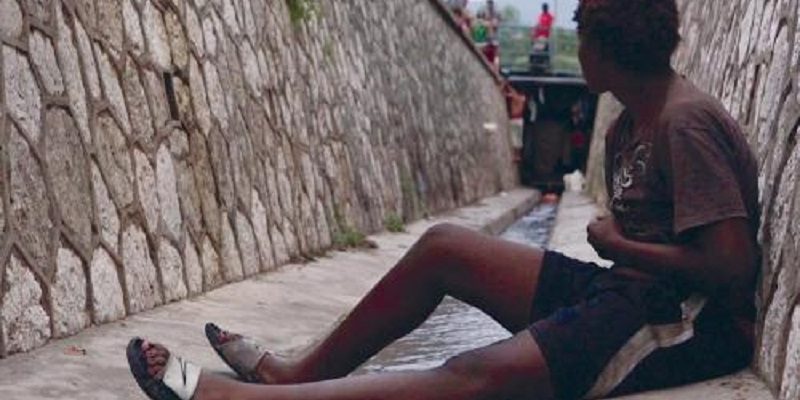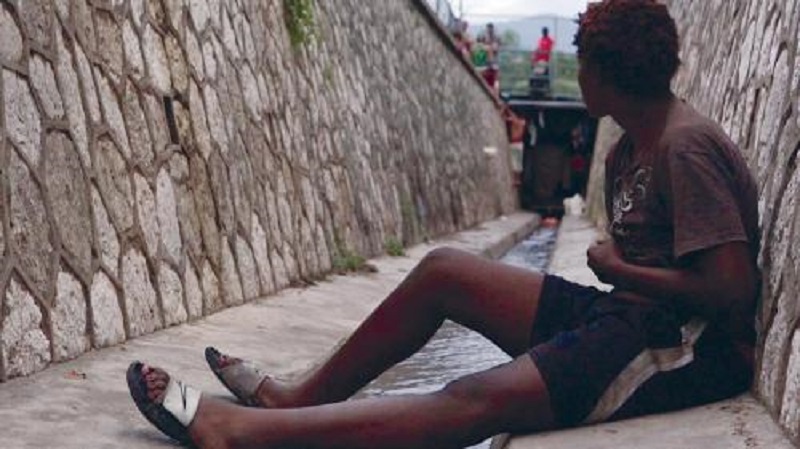
More effective collaboration across state agencies needed to address gaps in implementing policies, programmes that tackle concerns

A newly tabled report on children living and working on the streets in Jamaica has outlined the disturbing activities of and threats faced by the almost 1,000 youngsters, a third of whom are just 12- to 13-year-olds, scattered across the island.
The Child Protection and Family Services Agency’s (CPFSA) final report on a Study of Children Living and Working on the Streets in Jamaica, paints a grim picture of children forced, mainly through poverty, to hustle or beg on the streets, with exposure to prostitution, rape and otherwise violent behaviour among the experiences of many, even if not the majority.
Most of the youngsters interviewed work during the daytime (57 per cent doing so after school) most commonly selling snacks, ground provisions and newspapers, while more than a quarter of the study sample ‘wipe car glass’ and wash cars. A smaller proportion (12 per cent) hustle in night clubs and at parties.
“Beyond these, there are differing patterns of activity across the communities,” the report stated in its executive summary.
“In Kingston and St Andrew and St James, children who live off the dump also sell scrap metal, loom and copper. Children from one particular community collect money from sponsorship papers. There are reports that children are involved in prostitution, particularly in Kingston and St Andrew, St James, St Ann, St Mary and Westmoreland. Children who reside within fishing villages in St Catherine and Clarendon are occupied with various tasks in the boating business. However, some girls are involved in prostitution and/or beg for a living.”
The report added: “As in select communities in Kingston and St Andrew, prostitution appears to be learnt/observed behaviour. There is the tendency to consider this a rational response to poverty; therefore, one’s body is a ‘good’ that can be bartered for an income; at least in conversation,the girls or women involved explain that prostitution does not affect them internally.”
“…Boys traverse the streets in particular areas and are involved in homosexual and bisexual relationships. Their approach to boys and men on the streets is often threatening. There is also a pocket of youth and boys who, allegedly, are known for their involvement in aggravated assaults.”
Study of Children Living and Working on the Streets in Jamaica
The study also documented the prevalence of risky sexual practices among children on the streets with
children contending that bigger men proposition young boys and have sexual relations with them.
“Meanwhile, boys traverse the streets in particular areas and are involved in homosexual and bisexual relationships. Their approach to boys and men on the streets is often threatening. There is also a pocket of youth and boys who, allegedly, are known for their involvement in aggravated assaults,” the report stated.
“There were children who acknowledged their participation in violent activities, although subsequent interviews revealed that the actual proportions of these children are likely to be higher than the survey findings present.”
According to the report, while the majority of children who hustle on the streets do not feel threatened or pose threats, there are significant segments who threaten citizens and are, themselves at high risk of rape, assaults, abduction and death.
“Children and their parents are aware of this. Thus, those who venture to the major streets now comprise older and more hardened children who know the rules of the road.”

The CPFSA, headed by Chief Executive Officer Rosalee Gage-Grey and which operates under the Ministry of Education, Youth and Information, was, with technical assistance from Winrock International, seeking to “determine the factors that predispose children to be living and working on the streets (inclusive of trafficking victims that may be invisible), and to identify gaps in the provision of care and social protection services that impede an effective response to addressing street children”.
According to the child services agency, the results and recommendations of the study are to be used to inform policies,
programming, and interventions related to children on the streets in Jamaica.
Four hundred and thirteen questionnaires were administered to children across nine parishes – Kingston, St Andrew, St Catherine, Clarendon, Westmoreland, St James, St Ann, St Mary and St Thomas. Three hundred and seventy three of these quantitative responses were analysed; 40 questionnaires were considered incomplete to a level where they could not be used. These particular questionnaires comprised those where children ran off prior to completion and where children were involved in child labour but were not on the streets.
MOSTLY BOYS ON THE STREETS
The CPFSA said, of the 373 respondents, 230 were males and 137 females, while the highest proportion of children on the streets were 12 and 13 years old respectively. Twelve-year-olds comprised 15.72 per cent of the sample while 13-year-olds comprised 14.63 per cent. Thirty-eight 10-year-olds were interviewed while children between 15 and 17 years
comprised 28 per cent. Children between 5 and 9 years old made up 10 per cent of the sample.
The majority of respondents were located in Kingston and St Andrew (108), followed by St Catherine (85); St Ann (50); Westmoreland (42) and St Thomas (37).
At the same time, the estimated overall number of children on the streets, amounted to 890, with 330 in Kingston and St Andrew alone.
A previous study conducted by WORKERMANAGEMENT Services for the Child Support Unit of the Ministry of Health back in 2002, indicated that there was, at the time, a low of 2,818 (registered) and a high of 6,448 (estimated) children living and working in the island.
“Stakeholders suggest that, in St James, more children and adolescents may be involved in or taken care of by scamming; thus, fewer are on the streets. Only 11 children were interviewed in Clarendon; however, this was a direct outcome of the upsurge of violence in that area,” the report stated.
The study found that only five per cent of the children interviewed sleep on the streets while 94 per cent return home to sleep.
While children were for the most part hesitant to acknowledge that they ‘work’, they agreed that their activities could be considered ‘hustling’.
“In some communities, parents and children were proud to be labelled as hustlers,” the report stated.
“The major proportion (35 per cent) ‘hustle’, work or beg each day of the week while 16 per cent hustle four days per week and 18 per cent hustle three days in the course of the week.”
FACTORS PUSHING, PULLING CHILDREN TO STREETS
Significantly, the majority of children in the sample (72 per cent) attended school most days; 18 per cent
attended sometimes; 9.4 per cent used to attend but no longer do, while the remainder (less than one per cent)
never attended school.
In examining th root causes of children living or working on the streets, the study found that consumption poverty is the most obvious push factor for child labour while the potential for quick monetary gains is the most significant pull factor.
“However, when poverty is understood in its multidimensional sense, the research reveals the wider range of factors that cause poverty and, in turn, push children to the streets,” the report stated.
“Therefore, addressing consumption poverty alone will not solve the root issues. Conversely, attention must be paid to
the added burdens, which come from family break up or dislocation; gaps in the provision of quality education; limitations from learning challenges; adverse peer influence; the growing hustling culture; the inadequacy of safety nets; various forms of insecurity (economic, political, social, relational, food); the weights and limitations of common practices, such as witchcraft; power relations and dynamics that produce mindsets that cannot be solved by behaviour change programmes alone.”

The study suggested that, while appropriate legislation, policies and programmes are currently in place to address the concerns around children working and living on the streets, there is need for more effective collaboration across agencies, “where competition, different levels of commitment, variations in technical knowledge and lack of accountability have long undermined the concerted approach required to address the problems”.
“Any purposive programme of action should begin with defining and determining effective methods for managing implementation processes.”
The report stated that an effective programme requires deep and comprehensive interventions that are designed to:
- Acknowledge and address the norms, beliefs and values that influence choices, including for
child work on the streets, across and within communities; - Stem intergenerational inequalities, such that families can transcend those conditions of pov-
erty that underpin child work on the streets. This necessarily involves (a) implementing an ag-
gressive, transformative, income generation programme for parents and guardians; and (b) ar-
resting low educational achievement across generations; - Address learning and psychological challenges among children on the streets;
- Urgently tackle the factors that push children to the streets, including within the education sys-
tem; - Expand the programme to effectively prevent new cohorts of children from entering the streets;
- Implement child labour legislations in order to address children’s work on the streets; and
- Develop an effective marketing programme that will advocate against child work on the streets
while presenting credible options. Further, ensure that families are aware of available facilities,
including the Ministry of Labour and Social Security’s Education and Social Intervention Grant
and the Steps to Work project.

Back in April, Robert Morgan, state minister in the Ministry of Education, Youth and Information, revealed that the authorities were considering the termination of parental rights for persons who engage in child labour as one method to address the problem of children who live and work on the streets.
Morgan had indicated that a plan of action was being developed and that the issue was a challenging one because most of the children on the streets were not homeless and that their presence “clouds the real problem of some children who are on the streets because they have been abandoned”.
“Whenever someone puts their hand through the car door and gives a street child money, in many cases, they’re not performing a humanitarian action, they’re performing a capitalist action of demand and supply,” Morgan had said.
“Where there is a demand there will be a supply. If it is that persons stop giving – some of them are wiper boys – money at the stoplight, they will cease to exist.”







Comments